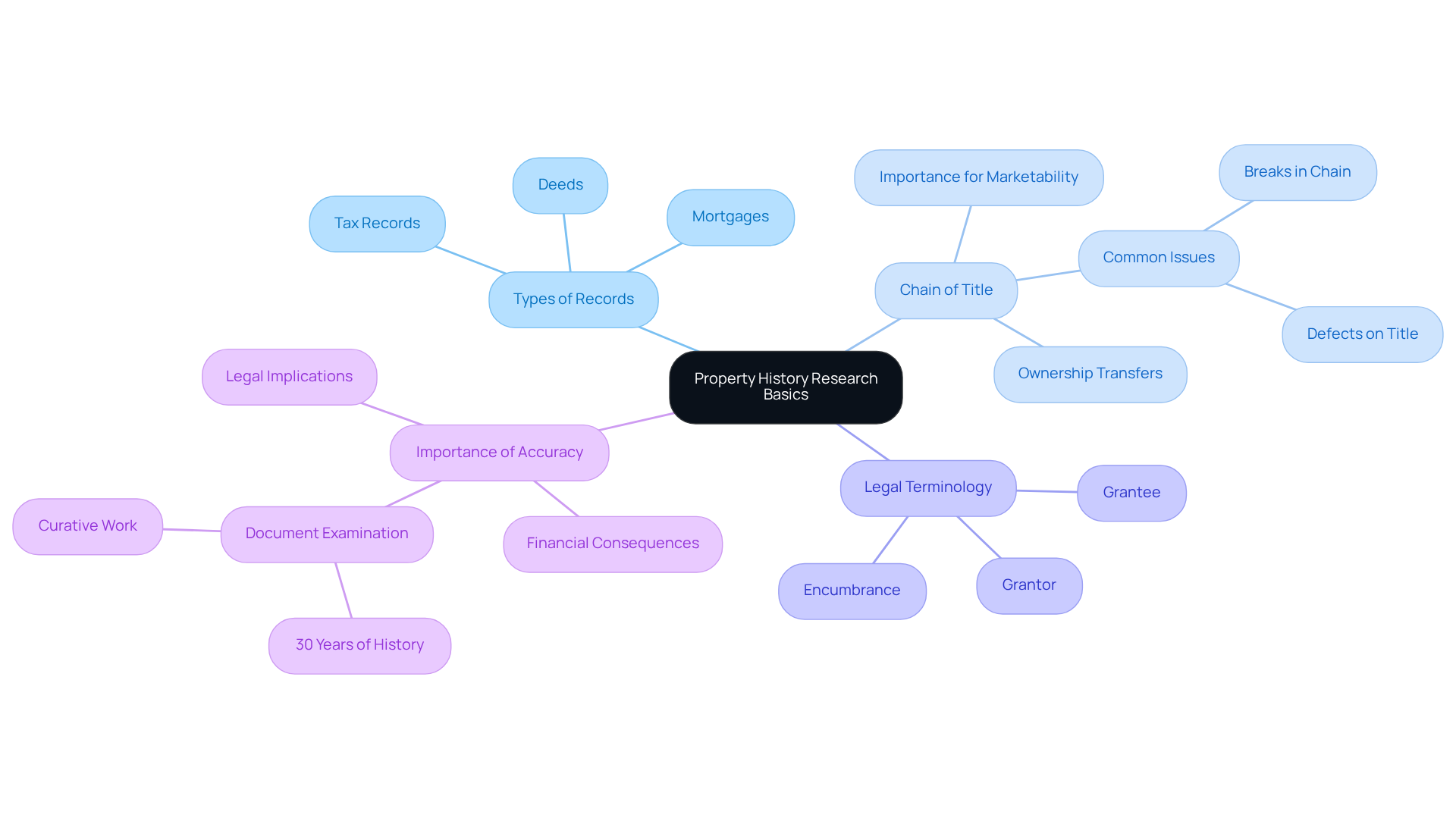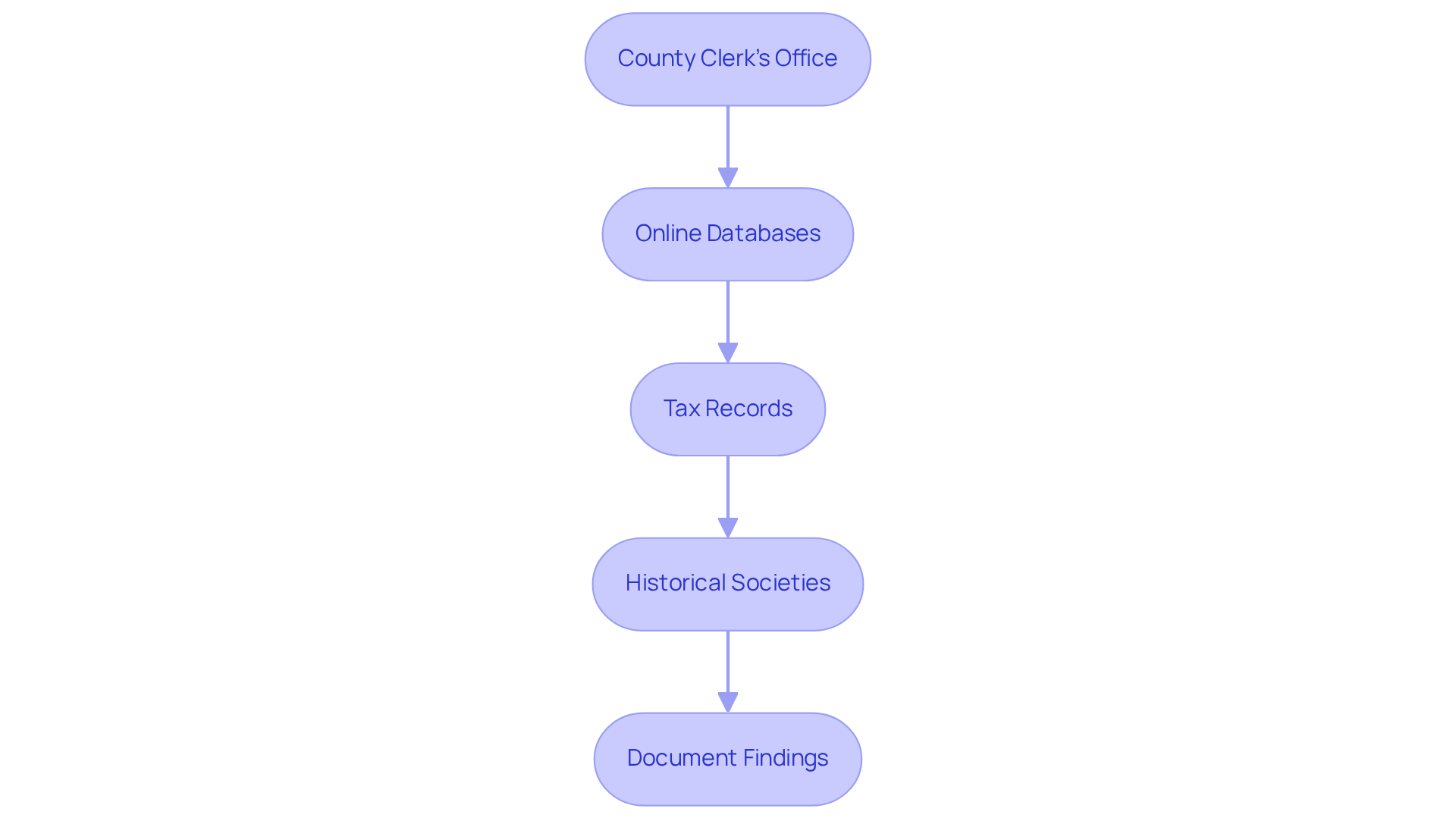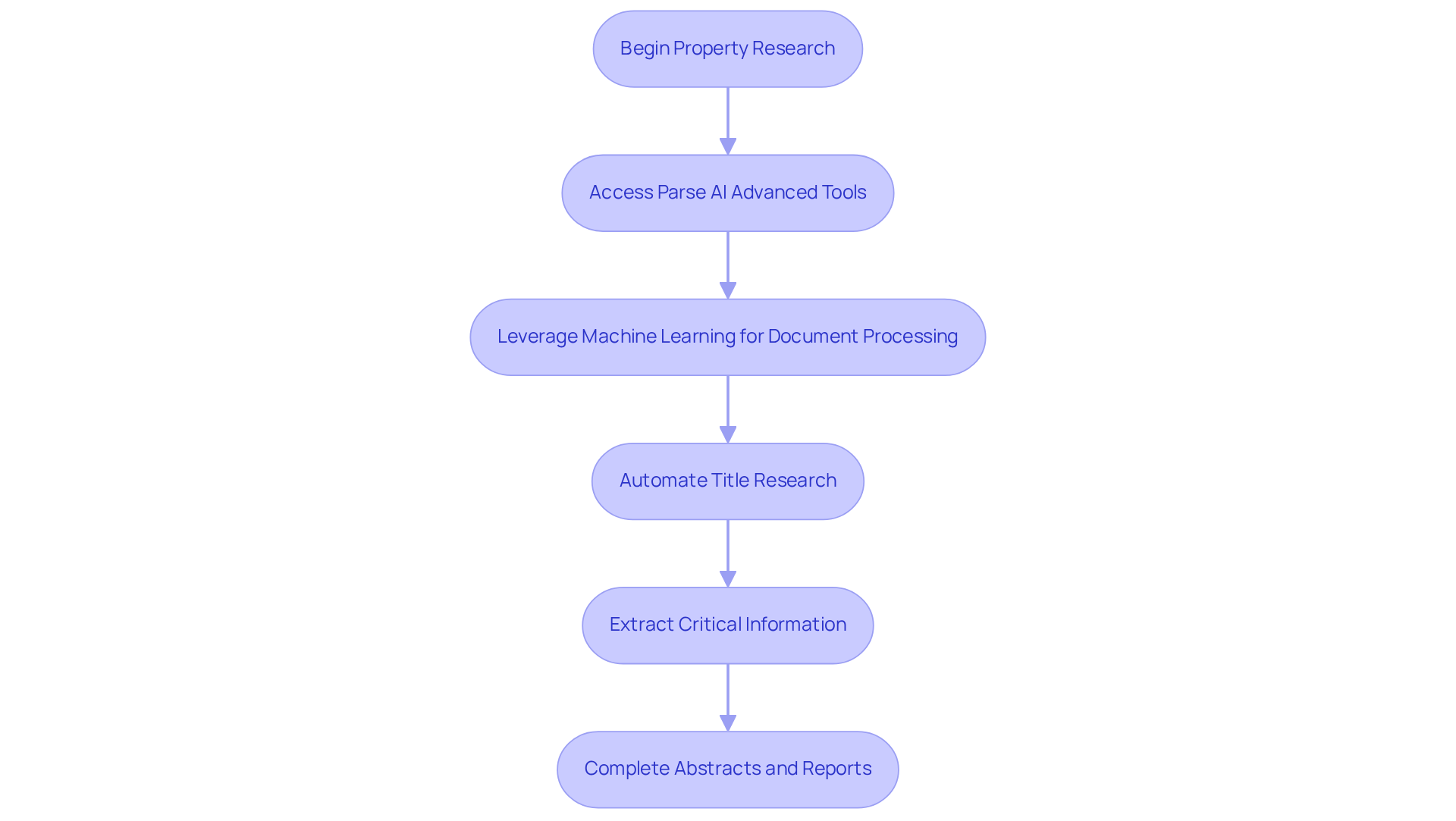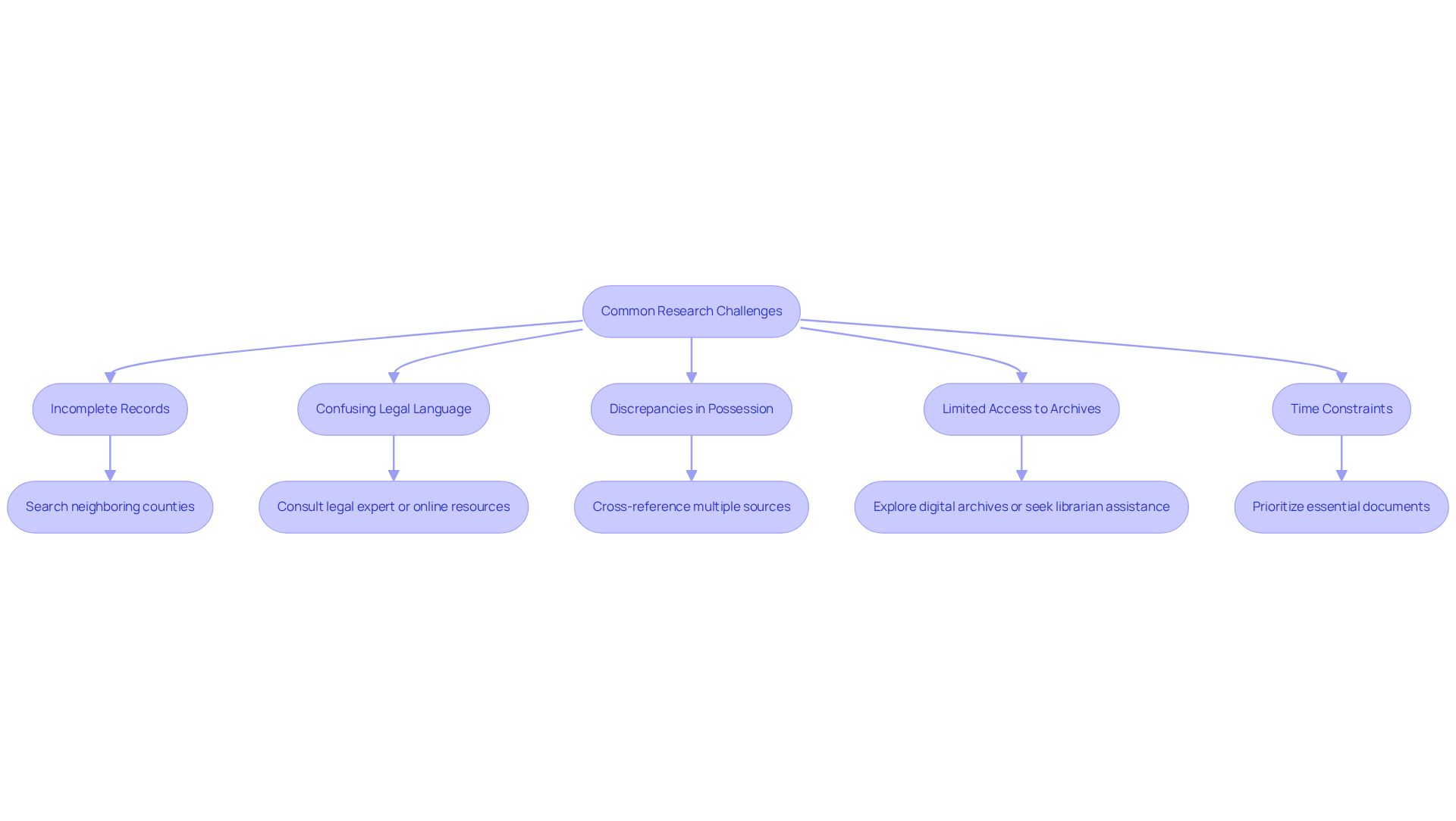Overview
To research property history effectively, one must adopt a systematic approach that encompasses the examination of legal documents, comprehension of the chain of title, and the utilization of both traditional and digital resources. This article delineates essential steps:
- Visit to the county clerk's office
- Review of tax records
- Consultations with historical societies
It underscores the critical importance of accuracy and thorough documentation to avert legal complications and affirm clear ownership.
Introduction
Researching property history stands as a crucial yet often overlooked aspect of real estate transactions. Understanding the intricate details of a property's past can unveil hidden truths that significantly impact ownership and financial obligations. However, this process is fraught with challenges—from deciphering complex legal documents to navigating incomplete records.
What steps can one take to ensure a thorough investigation? Furthermore, how can modern tools streamline this essential task?
Understand Property History Research Basics
To conduct real estate history research, one must know how to research property history by thoroughly examining a site's title and legal standing over the years. Understanding the fundamentals is crucial:
- Types of Records: Familiarize yourself with essential documents such as deeds, mortgages, and tax records. Each category provides distinct perspectives on the asset's history, uncovering vital details regarding possession and financial responsibilities.
- Chain of Title: This concept pertains to the historical sequence of ownership transfers for a real estate asset. A transparent sequence of rights is essential, as it confirms possession and can avert conflicts. As noted by HAR, "The sequence of ownership is an essential yet frequently neglected element in real estate dealings, outlining the history of ownership from the initial seller to the present owner." In fact, a well-documented chain of ownership is crucial for ensuring a marketable deed, necessary for selling or refinancing an asset.
- Legal Terminology: Understanding terms like 'grantor', 'grantee', and 'encumbrance' is essential for navigating legal documents effectively. Familiarity with these terms simplifies the investigation process and enhances communication with legal experts.
- Importance of Accuracy: The significance of accuracy in property title research cannot be overstated. A minor error in real estate calculations could result in substantial financial loss, making it imperative to ensure all information is correct. Mistakes can lead to considerable legal and financial consequences, complicating transactions and potentially nullifying claims to property. As highlighted, "Every transaction, from deeds to mortgages, is documented in public records to ensure clear ownership and is legally valid." Furthermore, a document examination typically encompasses 30 years of ownership history, underscoring the extent of investigation required. Curative work is also essential in resolving issues within the chain of title, ensuring that all discrepancies are addressed.
By mastering these fundamentals, real estate experts can improve their understanding of how to research property history, ultimately leading to smoother transactions and minimized risks.

Follow Step-by-Step Research Procedures
To conduct thorough property history research, follow these essential steps:
-
Begin at the County Clerk's Office: Start by visiting or contacting your local county clerk's office to obtain land records. Focus on the most recent proprietor and trace back through the chain of title. This critical step is vital for learning how to research property history, as land records have been maintained since as early as 1200. Such comprehensive investigation is significant for grasping ownership.
-
Search Online Databases: Leverage online resources, such as state or county land databases, to locate deeds and other relevant documents. Platforms like Massachusetts Land Records are particularly beneficial, highlighting the growing trend of digitization in real estate inquiries that enhances accessibility and efficiency. Innovations like Parse AI, which employs machine learning and optical character recognition, further streamline the title research process.
-
Review Tax Records: Examine real estate tax records to confirm ownership and identify any outstanding taxes or liens on the asset. This step is essential for understanding the financial obligations associated with the property.
-
Consult Historical Societies: Local historical societies often preserve archives that contain photographs, maps, and documents, providing important context regarding the site's history. Engaging with these resources can reveal insights into architectural styles and former occupants, thereby enriching your investigation. For example, exploring a home's history might uncover details about an ancestor's wealth and social status.
-
Document Your Findings: Maintain detailed notes of your findings, including dates, document types, and any discrepancies encountered. This thorough documentation will assist in constructing a comprehensive overview of the asset's history, facilitating future investigations and inquiries.
By adhering to these steps, you can effectively navigate the intricacies of how to research property history, utilizing both conventional and contemporary resources to uncover the rich narratives behind ownership.

Utilize Resources and Tools for Effective Research
To enhance your property history research, it is essential to know how to research property history using effective resources and tools. Parse AI's Advanced Tools stand out as a powerful solution. By leveraging Parse AI's machine learning capabilities, you can expedite document processing and automate title research. This platform enables efficient extraction of critical information from title documents, allowing title researchers to complete abstracts and reports with greater speed and accuracy. Furthermore, the example manager feature facilitates quick annotation of individual examples, streamlining the extraction of information from extensive sets of unstructured documents.

Troubleshoot Common Research Challenges
When considering how to research property history, several challenges may arise. Understanding how to troubleshoot these issues is crucial for effective research:
-
Incomplete Records: Gaps in the records can be problematic. To address this, consider searching neighboring counties or jurisdictions, as property lines may have evolved over time. This strategy can reveal valuable information that might not be present in the primary records.
-
Confusing Legal Language: Legal documents often contain dense and complex language. To navigate this, consulting a legal expert or utilizing online resources that clarify common legal terms is advisable. As real estate attorney Roy Oppenheim emphasizes, mastering this language is essential to avoid misinterpretations that could result in costly errors.
-
Discrepancies in Possession: Conflicting information regarding possession can complicate matters. Cross-referencing multiple sources, including tax records and historical documents, can help clarify the situation. This is particularly significant, as ownership conflicts may arise if a landowner passes away before selling the property, especially when unknown or absent heirs assert their claims.
-
Limited Access to Archives: Accessibility issues with local archives can hinder research. In such cases, exploring digital archives or seeking assistance from librarians can provide alternative resources. Librarians are often well-equipped to direct you to online databases that may contain the necessary information.
-
Time Constraints: If time is limited, prioritize your investigation by focusing on the most essential documents first, such as the chain of title and any liens or encumbrances. For instance, a tax lien on real estate may serve as a warning sign for prospective buyers, yet it is not inherently a dealbreaker, as liens are tied to the asset rather than the owner.
By implementing these strategies, you can adeptly navigate the complexities of property research and understand how to research property history to mitigate potential issues that may arise during the process.

Conclusion
Understanding property history is paramount in real estate transactions, offering insights that can profoundly influence ownership decisions. By mastering the intricacies of property history research, individuals can ensure they are well-informed about a property's legal standing and past ownership, ultimately leading to more secure investments and smoother transactions.
This article outlines essential steps for conducting thorough property history research. Key actions include:
- Familiarizing oneself with various records
- Grasping legal terminology
- Utilizing both traditional and digital resources to gather information
The importance of accuracy in documentation and a systematic approach to uncovering a property's past are emphasized, showcasing how meticulous investigation can avert costly mistakes and disputes.
Engaging in comprehensive property history research not only safeguards personal investments but also contributes to a more transparent real estate market. By taking the time to explore the rich narrative behind each property, individuals can make informed decisions and cultivate a deeper appreciation for the significance of property history. Embrace the tools and strategies discussed, and empower yourself to navigate the complexities of property research with confidence.
Frequently Asked Questions
What is the purpose of property history research in real estate?
The purpose of property history research is to thoroughly examine a site's title and legal standing over the years, which helps in understanding the asset's history and ownership transfers.
What types of records are important for property history research?
Important types of records include deeds, mortgages, and tax records, as each provides distinct perspectives on the asset's history, including details regarding possession and financial responsibilities.
What does the term "chain of title" refer to?
The chain of title refers to the historical sequence of ownership transfers for a real estate asset, confirming possession and helping to avoid conflicts.
Why is a well-documented chain of ownership important?
A well-documented chain of ownership is crucial for ensuring a marketable deed, which is necessary for selling or refinancing an asset.
What legal terminology should one understand when conducting property history research?
Important legal terms to understand include 'grantor', 'grantee', and 'encumbrance', as familiarity with these terms simplifies the investigation process and enhances communication with legal experts.
Why is accuracy important in property title research?
Accuracy is vital because a minor error in real estate calculations can lead to substantial financial loss and legal complications, potentially nullifying claims to property.
How far back should property history research typically go?
Property history research typically encompasses a document examination of 30 years of ownership history.
What is curative work in the context of property history research?
Curative work involves resolving issues within the chain of title to ensure that all discrepancies are addressed, which is essential for a clear ownership record.




